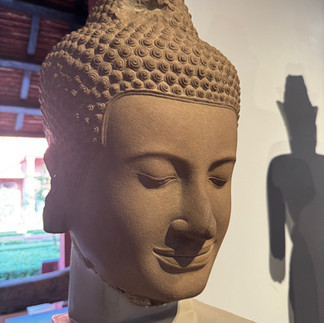The exterior alone should be reason enough to visit this place! It is absolutely stunning. In contrast to the myriad of shades of yellow of the Cambodian Royal Palace, this entire complex is seeped in the deep hues of oxblood and cinnabar reds.

Even more interesting is the fact that it's to exist, considering how during the reign of Pol Pot and the Khmer Rouge any and all forms of arts or culture were forbidden (or destroyed,) it's amazing that this building was merely locked up and shut down, and not razed to the ground.
Luckily, a reopened, Cambodia found the museum merely in a desolate condition: collapsed, roof, humidity damage, etc. These are things that could be repaired!
Since then, two side-wings have been added, making the building, even more impressive as it has a formal, closed in courtyard.
The museum is a collection of various artifacts, primarily bronzes and statues that span the period from pre-Angkorian Funan through Chenla and the Khmer Empire of Angkor, Kambuja (for more information on these three kingdoms, please see the block entry linked below).
Now: some expectation management…
It is a nice museum, where you can spend approximately 1 to 2 hours in before you've seen pretty much everything (it's not that large).
And, to be honest: I found the museum in Siem Reap to be much more interesting, as it also told the story of the history of this country through its various phases, ... whereas this museum is more a museum of sculptures – beautiful sculptures, yes, but sculptures .
To anyone who ever studied the development of sculpture in ancient Greece, you'll be thrilled to see many parallels!
The earliest sculptures, like the Ionian works of ancient grace, or "slightly disproportionate", to put it nicely, with short, thick legs, standing like columns to support the sculpture.
Later works show a gracefulness in body movement that is as inspiring as classical Greek sculpture:
I'm going to guess that here, too, Alexander the Great was responsible (indirectly):
He brought classical Greek sculpture to India, which revolutionized the statues of Buddha. And I am sure that the strong Hindu/Indian connection with the ancient Khmer Empire meant that this revolution in art was then passed from India on to Cambodia....
Lingas and Yonis
Yes, no art collection would be complete without the Hindu male and female fertility symbols. Although the Linga, the male phallic symbol, can be quite obvious, the female, or Yoni, requires a bit of imagination.
When the two are joined together, as one sculpture in union, it's more geometric than pornographic, so safe for kids as well!
This reminds me of an upcoming station of my tour this year: Phnom Kulen - where the sacred waters flow from the holy mountain down towards Angkor. Here, the entire river bed is carved with Linga and Yoni, and the water flowing over the symbols supposedly absorbs the gift of fertility, which the water then brings to the rice fields ...
a sort of conveyor belt blessings if you will !
But that's a different blog, when I get to it















































































Comments